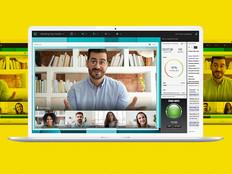Leading the Charge: Higher Ed IT Leaders Can Drive Digital Workplace Adoption
When tech-savvy IT professionals call a product disruptive, chances are they mean innovative. But when a seasoned, traditionally minded academic calls something disruptive? Chances are he means it in the most literal sense.
Such is the environment in which higher education leaders find themselves working to implement digital workspaces and their promises of simpler, more unified managed IT environments.
It’s not always an easy sell. As noted by CIO, while this type of digital transformation is critical to drive change, it’s also a “necessary disruption” that can potentially interfere with systems and services until students and staff get up to speed.
And that’s not the only hurdle.
The evolving IT skills gap also poses a challenge. With more than 700,000 unfilled technology jobs across the U.S., colleges and universities compete for the same talent as enterprises, but often lack big salaries and potential perks of private sector firms. Speed, too, is a factor: “Exponentially, IT folks are asked to move, respond and implement faster,” says Adrienne Esposito, director of enterprise infrastructure at Rutgers University.
While higher ed institutions recognize the value of digital workplace adoption, making the shift is complicated. With the following five steps, however, research firm Deloitte offers a plan to help IT teams lead the charge in digital workplace deployments.
1. Assess Your Current State
Colleges and universities occupy a unique IT space. Their end-user population — largely composed of faculty, staff and students — often have higher expectations for access and availability, along with less willingness to accept IT restrictions or diminished service.
“The hardest part is that we’re working in an enterprise environment that doesn’t have the same level of flexibility,” Esposito says. As educational IT teams naturally transition to enterprise-grade offerings, there’s a proportionate focus on security and control. In fact, Esposito’s team has encountered “a lot of push back along the way, not because of the applications themselves, but because of their limitations.”
As a result, it’s critical to start any digital workplace transition with a thorough assessment of what’s working in campus IT, how improvements can be made and where challenges may emerge. At Rutgers, Esposito says, this means “partnering throughout the university to develop governance and standards with a leadership council led by the CIO who works directly with deans across campus.”
2. Develop an Adoption Strategy
As noted by EDUCAUSE, some of the top IT issues in 2020 for digital transformation in higher education include administrative simplification, information security strategy development and sustainable funding formulas.
For Esposito, achieving these goals means creating a plan. “We’ve been working for about two years on the network master plan,” she says, along with “getting a sustainable funding model in place to support future needs, one that gets us where we need to be today and tomorrow.”
3. Select Tools and Technologies
For university IT teams, it’s critical to select tools and technologies that meet specific needs and accomplish defined goals. “I wish that all products seamlessly integrated and you could focus solely on best-of-breed,” says Esposito. “Unfortunately, it’s not the way applications and vendors are going.”
Rutgers IT, she says, has adopted Slack at scale to improve internal communications, along with Office 365 to provide simplified collaboration and cloud connections for students. The university has also implemented ServiceNow to help streamline IT ticketing and response.
Here, IT teams must leverage assessment results and strategy goals to inform solution adoption. By linking tool selection to key technology needs, schools can ensure that functionality and funding go hand in hand.
4. Execute Change Management
Effectively transitioning to a digital workplace environment requires the help of skilled IT pros. While finding great talent has historically been difficult for universities, Esposito says that her ability to fill key positions has recently improved. The difference?
“We’re looking for new skills,” she says. “The hunger to learn, a mindset that’s adept at troubleshooting. We’ve shifted the skill set.”
By moving away from traditional degrees and certifications and instead prioritizing skills and abilities, Esposito has been able to identify key staffing requirements and find ideal candidates, thus increasing her ability to effectively execute digital change management.
5. Measure the Ongoing Impact
Deploying effective digital workplace tools doesn’t work with a set-and-forget mindset. IT teams must continually assess their efficacy and impact. In part, this means changing how technology staff communicate with other departments on campus. This requires a significant shift. “We’re no longer a service provider,” Esposito says. “We’re now a service partner.”
There’s also the need to observe the way users leverage or work around the technology tools that they’re provided. Esposito recalls a conversation she overheard between two students talking in a campus coffee shop.
The first asked her friend, “Have you gotten on that secure wireless thing yet?” The second replied that she hadn’t. It was too complex, and she gave up. While Esposito’s first reaction was to offer assistance and fix the problem for these students, she realized a more important change was required to streamline the network at large.
Driving Success
For Esposito, the purpose of digital workplace deployments is clear: to make campus IT as “understandable, simple and seamless as possible.” But a piecemeal approach won’t drive long-term results, she says. Only with a comprehensive plan can postsecondary schools deliver that kind of change at scale and, in turn, maximize IT impact.








